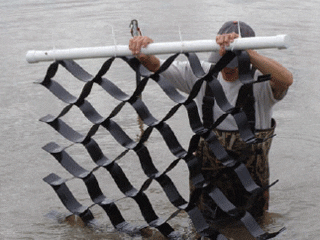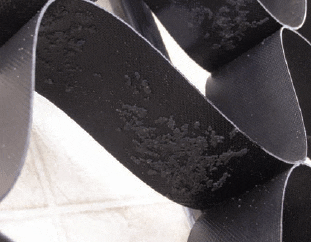Previous articles in Arkansas Aquafarming reported that over 1.5 million/ acre of feeder size fathead minnows could be produced by stocking hatchery fry into small ponds for intensive culture (feed and aeration).

Fathead minnow eggs can be removed from spawning substrate with a 1.5 percent sodium sulfite solution and hatched in jars. However, leaving eggs attached to substrate for incubation in tanks (as is done for goldfish and most golden shiners) is another option, if a suitable compact substrate can be found. We have been testing a commercially-available plastic geoweb material (cellular confinement system used for slope stabilization) as a spawning substrate.
It consists of 3- inch-wide, textured high density plastic strips welded together to form a series of cells (EnviroGrid EGA 203T- 29, textured, not perforated; available from vendors such as Geo Products and U.S. Fabrics). This material was selected based on fathead minnow biology; the textured surface helps retain eggs, and the narrow width and cellular form were chosen because fatheads appear to prefer to nest near the edges of substrates and also near each other, in colonies.

A single geoweb panel opens up to 8.4 feet deep, and 21.4 feet long, and costs around $200, including delivery. Quantity orders may be discounted. For use in ponds, the panel would need to be cut in half to reduce the depth to around 4 feet. For ease in handling and to fit in hatching tanks, cutting the length into halves or thirds may be necessary. Given the expense, this substrate would likely be reserved for indoor hatching only.
A nice feature of the cellular material is that the 4 foot depth can be reduced for hatching in tanks; the cells collapse together and the depth can be reduced by half or so without damage to the majority of eggs.
The material will need to be suspended from a float (e.g., PVC pipe), and a weight will be needed at the bottom to sink the material. For the latter, we have used a small diameter PVC pipe (e.g., ¾ inch, filled with sand and capped) zip-tied to the bottom cells of the substrate.
We will be testing tank hatching of fathead minnow eggs on geoweb substrate this next season, and also will be placing some sections of the substrate in ponds of cooperating producers, to evaluate egg deposition and substrate durability. As a reminder, fathead minnow eggs will require daily treatments with a fungicide (e.g., formalin, hydrogen peroxide) during incubation, as the eggs readily fungus.
February 2012
